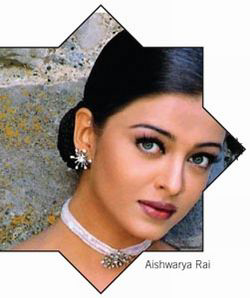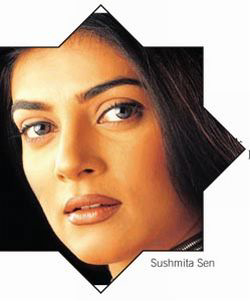Arts
Beauty's Beast
|
Indian women are being exhorted to live up to Western beauty standards. Ironically, while we have more educated and financially independent Indian women than ever before, regressive images of women permeate throughout the Indian entertainment industry.
I wonder whether Pulitzer Prize-winning author Susan Faludi’s theory of “backlash” against feminism in North America is playing out in Indian society. Lata Mangeshkar, after all, never had to expose herself the way V.J. Sophiya has to get attention from a song video. What happened? Rewind to the 1980s and 1990 and take note of the body types of Bollywood actresses and models then. Sreedevi was plump. At 5 feet 8 inches, actresses like Rekha and Zeenat Aman were aberrations in height. Juhi Chawla and Meenakshi Seshadri, both 5 feet 3 1/2 inches, were former Miss Indias and models. Madhuri Dixit was big breasted with rounded hips, like so many other actresses of her era. Fast forward to 1992. Madhu Sapre becomes runner up for Miss Universe. She’s the first Miss India after several years to even come close. Sushmita Sen and Aishwarya Rai follow soon after and are crowned Miss Universe and Miss World respectively in 1994. Incidentally, both are 5 feet 9 inches and their bodies are also straighter, compared to the typical curves many Indian women have. This, oddly enough, is in synch with the Western trends of the time. During the same period, India opened up its economy, drawing an onslaught of multinational corporations. A demand had to be created for Indian consumers to buy their products and Suzanne Sommers wasn’t going to cut it. This is similar to what occurred in North America after the rise of the women’s movements in the 1970s. The sales of cosmetics and clothing began to decline precipitously in the early 1980s. So the industry began to pitch its products at impressionable teenagers and young women. Eventually, a generation of women was groomed to feel bad about themselves to the point that they would buy products designed to give them the waif-like Kate Moss-Calvin Klein look. Pageant Backgrounds
The Miss Universe Pageant founded in 1952 by a California clothing company to showcase its swimwear, was acquired by Donald Trump with television rights owned by NBC. Miss World is U.K.-based with a lot of commercial clout. Making Indians their mascots was of great commercial interest to both organizations. During all the years that India’s economy was closed, no Miss Indias hovered even close to the Miss Universe title and only one won a Miss World title in 1966. Once the country opened up, Indians began to dominate beauty pageants. Four Indians have won the Miss World crown in the last decade. In 1994 and 2000 Indian women won both the Miss World and Miss Universe titles. After Sushmita Sen and Aishwarya Rai were crowned Miss Universe and Miss World respectively in 1994, the Miss India contest saw a surge in applicants. Many of these women are aspiring architects, engineers, etc., as beauty contests are an indulgence that only the middle or upper class can afford in India. The same is also true for Bollywood. Where the Indian film industry attracted primarily women with low educational attainment, many of the new actresses are highly educated. It is not that Indian models suddenly became more beautiful; the rise of Indians in the beauty pageant scene was driven by a consumer feeding frenzy. It has worked, as parents exhort daughters to dress to impress and to have “fit” figures. The dream of international success is now the middle class Indian woman’s fantasy. It is a fantasy. While many famous Indian models have indeed done stints abroad, none have acquired enduring international stature even after winning the Miss Universe or Miss World titles. Even Aishwarya Rai, whose forceful self-promotion won her considerable exposure in the American media, has discovered that the recognition has been fleeting. She lingers mostly in the memories of desis living here rather than the mainstream. The advent of Westernization and consumerism also introduced Indians to MTV and Channel V. Many spheres of the entertainment world intersect here. English-speaking Western faces gracing these channels weren’t working. So Ruby Bhatia and Kamal Sidhu, both Canadian Indians, were recruited to bridge the Indian and Western worlds. Hindi music videos began to emulate Madonna and Western video practices. In the West, music videos often employ shock value as a marketing gimmick to “attract” male viewers. In India, it was no different.
In the face of public criticism of vulgarity, however, several song and video producers changed their tunes. They began remixing obscure old song, oftentimes sensationalizing the videos by depicting women in dehumanizing ways. Such was the level of dehumanization that girls used in “Chadti Jawani” in their white-laced lingerie were based on a child’s angel doll set. Sadly, if women don’t shed their clothes, they don’t get noticed or at least that’s what producers will have you believe anyway. Or, as is the case with Ila Arun, if you don’t want to do it yourself, hire models who will. “The winner has to be able to represent the country and have a good combination of everything – not only beauty,” commented Bipasha Basu, model and actress. Besides posturing as a person who probably doesn’t exist, Basu conforms to questionable Western modeling standards. Genetically, Indian women are structured differently and as is the case with any civilization, they come in different physical forms, so their media portrayals should be more reflective. The ethnic factor within the context of the Indian race is often overlooked. People from certain regions and castes tend to have features the entertainment industry favors. In some instances, there is a mixing of genotype. While one may appreciate the beauty of Katrina Kaif and Lisa Ray, who are half-Indian and half-English and Polish respectively, those with only Indian genes cannot hope to replicate their physical appearance. Indian women are being exhorted to live up to Western beauty standards in a fool’s paradise. It’s not that people don’t have a right to create a name for themselves in these arenas, but they should do it by being themselves and not by masquerading to some false standard. For too long women have been made to feel that they are not good enough as themselves. It’s time for them to realize that we’re not just good, we’re great. Let’s be real. |



